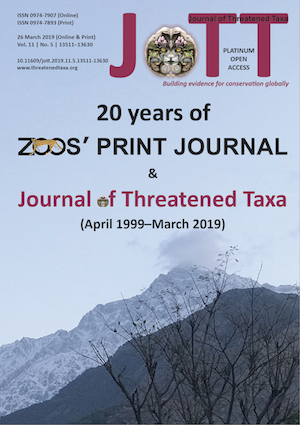Food composition of Indian Eagle Owl Bubo bengalensis Franklin (Aves: Strigiformes: Strigidae) from Tiruchirappalli District, Tamil Nadu, India
DOI:
https://doi.org/10.11609/jott.4416.11.5.13545-13551Keywords:
Amphibians, arachnid, Bandicota bengalensis, insects, Millardia meltada, pellet analysis, prey composition, reptiles, rodents, shrewAbstract
The diet of the Indian Eagle Owl was studied from April to September 2017 in Tiruchirapalli District, Tamil Nadu, India. Analysis of 1082 regurgitated pellets yielded 2077 prey items; the mean prey items/ pellet was 1.91. The diet constituted 65.1% of rodent prey and the remaining 34.83% of other groups of both vertebrate and invertebrate animals. The mean percentage of prey composition was 31.15% Millardia meltada Soft-furred Field Rat, 12.95% Bandicota bengalensis Lesser Bandicoot Rat, 10.25% Mus booduga Indian Field Mouse, and 10.24% of other rodent species. Of the 34.83% of non-rodent prey, the owls ingested insects (Rhinoceros beetles, 9.58%), Arachnida (Solifugae or Sun spider, Galeodes sp., 9.58%), reptiles (Calotes sp., 3.7%), amphibians (3.56%), shrews (Suncus murinus, 2.84%), and others (5.57%). The Indian Eagle Owls consumed more than one prey per day and chiefly foraged in agricultural crop fields and consumed both small mammals and insects of agricultural importance under crop ecosystems.
References
Marks, J.S., R.J. Cannings, H. Mikkola, D.H. Holt, R. Berkley & C. Deppe (1999). Family Strigidae (typical owls), pp34–243. In: del Hoyo, J., A. Elliott & J. Sargatal (eds.). Handbook of the Birds of The World - Vol. 5 Barn-owls to hummingbirds. Lynx Edicions, Barcelona.
Marti, C.D. (1987). Raptor food habit studies, pp67–79. In: Pendleton, B.G., B.A. Millsap, K.W. Kline & D.A. Bird (eds). Raptor Management Techniques Manual. National Wildlife Federation Scientific Technical Service, No.10, Washington D.C.
Nagarajan, R., P. Neelanarayanan & R. Kanakasabai (1993). Tips for the identification of Common Barn Owl nests. Newsletter for Birdwatchers 33(5): 93.
Neelanarayanan, P. (2007). Diet of Barn Owl Tyto alba stertens, Hartert, (1929) in a portion of Cauvery delta, Tamil Nadu, India. Zoos’ Print Journal 22(8): 2777–2781. https://doi.org/10.11609/JoTT.ZPJ.1670.2777-81
Neelanarayanan, P., R. Nagarajan & R. Kanakasabai (1995). The Common Barn Owl, Tyto alba: a potential predator of rodent pests. Pestology 19(9): 34–37.
Neelanarayanan, P., R. Nagarajan & R. Kanakasabai (1998). Studying diet of Barn owl (Tyto alba stertens) by Pellet analysis, pp125–131. Proceedings of the First National Symposium on Birds in Agricultural Ecosystem, A.N.G.R. Agricultural University, Hyderabad.
Pande, S., & N. Dahanukar (2011a). Ecological effects on morphometric development of the Indian Eagle Owl Bubo bengalensis. Journal of Threatened Taxa 3(4): 1677–1685. http://doi.org/10.11609/JoTT.o2609.1677-85
Pande, S., & N. Dahanukar (2011b). The diet of Indian Eagle Owl Bubo bengalensis and its agronomic significance. Journal of Threatened Taxa 3(8): 2011–2017. https://doi.org/10.11609/JoTT.o2536.2011-7
Pande, S., A. Pawashe, M. Mahajan, A. Mahabal, C. Joglekar & R. Yosef (2011). Breeding biology, nesting habitat, and diet of the Rock Eagle-Owl (Bubo bengalensis). Journal of Raptor Research 45(3): 211–219. https://doi.org/10.3356/JRR-10-53.1
Penteriani, V., M.M. Delgado, C. Maggio, A. Aradis & F. Sergio (2005). Development of chicks and predispersal behaviour of Young in the Eagle Owl bubo bubo. Ibis 147: 155–168.
Ramanujam, M.E. (2003). On the “Long Call†of the Indian Great Horned or Eagle-owl Bubo bengalensis (Franklin). Zoos’ Print Journal 18(7): 1131–1134. http://doi.org/10.11609/JoTT.ZPJ.18.7.1131-4
Ramanujam, M.E. (2004). Methods of analyzing rodent prey of the Indian Eagle Owl Bubo bengalensis (Franklin) in and around Pondicherry, India. Zoos’ Print Journal 19: 1492–1494. http://doi.org/10.11609/JoTT.ZPJ.1117a.1492-4
Ramanujam, M.E. (2006). On the prey of the Indian Eagle Owl Bubo bengalensis (Franklin, 1831) in and around Pondicherry, southern India. Zoos’ Print Journal 21(5): 2231–2240. http://doi.org/10.11609/JoTT.ZPJ.1425.2231-40
Ramanujam, M.E. (2007). A catalogue of auditory and visual communicatory traits in the Indian Eagle Owl Bubo bengalensis (Franklin, 1831). Zoos’ Print Journal 22(8): 2771–2776. http://doi.org/10.11609/JoTT.ZPJ.1572.2771-6
Ramanujam, M.E. (2010). Some observations on the spread-winged agonistic displays of the Indian Eagle Owl Bubo bengalensis (Franklin, 1831). Journal of Threatened Taxa 2(9): 1147–1152. https://doi.org/10.11609/JoTT.o2249.1147-52
Ramanujam, M.E. (2015). Time budget and behavioural traits of adult and young Indian Eagle Owl Bubo bengalensis (Franklin, 1831) in and around a nesting site: a preliminary report. Journal of Threatened Taxa 7(14): 8139–8147. https://doi.org/10.11609/jott.2429.7.14.8139-8147
Ramanujam, M.E., & T. Murugavel (2009). A preliminary report on the development of young Indian Eagle Owl Bubo bengalensis (Franklin, 1831) in and around Puducherry, southern India. Journal of Threatened Taxa 1(10): 519–524. https://doi.org/10.11609/JoTT.o1762.519-24
Ramanujam, M.E & T. Singh (2017). A comparative study of the diet of the Indian Eagle Owl Bubo bengalensis (Franklin, 1831) from two distinct habitats in the Tamil Nadu - Puducherry area, southern India. Journal of Threatened Taxa 9(3): 9892–9902. https://doi.org/10.11609/jott.2438.9.3.9892-9902
Santhanakrishnan, R. (1995). Ecology of Barn Owl, Tyto alba (Scopoli) with special reference to its population, feeding and breeding in Mayiladuthurai, Tamil Nadu, south India. PhD dissertation, Bharathidasan University, Tiruchirappalli, South India.
Talmale, S.S., & M.S. Pradhan (2009). Identification of some small mammal species through owl pellet analysis. Records of the Zoological Survey of India, Occasional Paper No. 294: 1–44.
Taylor, I.R. (1994). Barn Owls: Predator Prey Relationships and Conservation. Cambridge University Press, Cambridge, U.K., 303pp.
Published
Issue
Section
License
Authors own the copyright to the articles published in JoTT. This is indicated explicitly in each publication. The authors grant permission to the publisher Wildlife Information Liaison Development (WILD) Society to publish the article in the Journal of Threatened Taxa. The authors recognize WILD as the original publisher, and to sell hard copies of the Journal and article to any buyer. JoTT is registered under the Creative Commons Attribution 4.0 International License (CC BY), which allows authors to retain copyright ownership. Under this license the authors allow anyone to download, cite, use the data, modify, reprint, copy and distribute provided the authors and source of publication are credited through appropriate citations (e.g., Son et al. (2016). Bats (Mammalia: Chiroptera) of the southeastern Truong Son Mountains, Quang Ngai Province, Vietnam. Journal of Threatened Taxa 8(7): 8953–8969. https://doi.org/10.11609/jott.2785.8.7.8953-8969). Users of the data do not require specific permission from the authors or the publisher.





